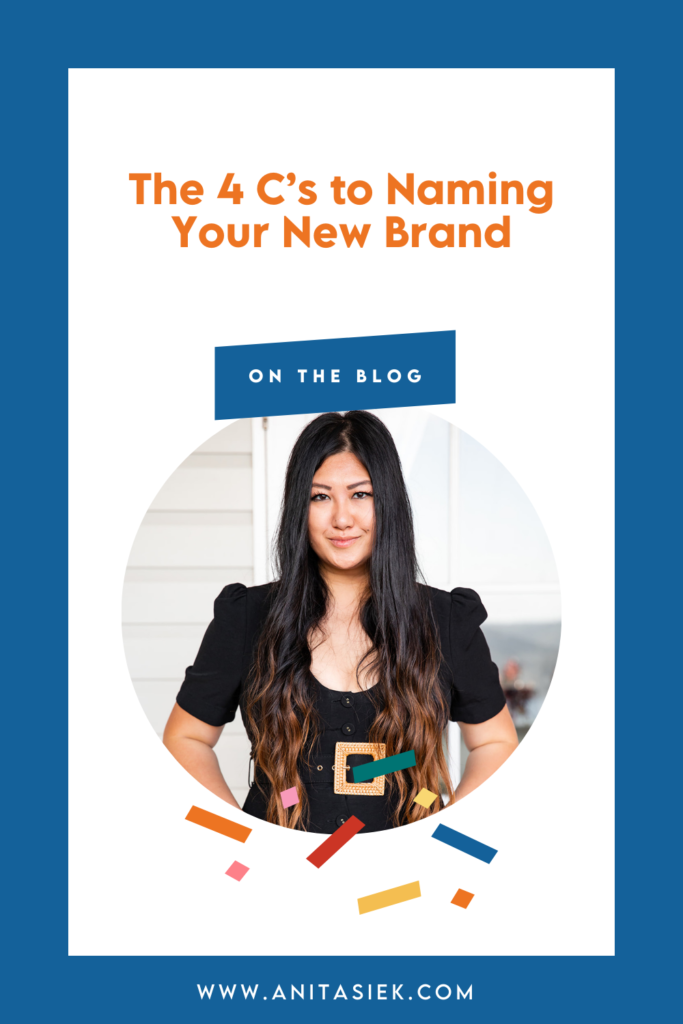The Anita Siek Blog
The Brandfetti Podcast
The Wordfetti
Shop
Podcast
Personal
Content Magic
Business
Lawyer (yep-a-dee-yep, I used to write things people never read) turned Brand and Copy Strategist, and Word-ucator for brands like you, who want to ZIG when others zag.
Hi, I'm Anita!
How to Brand Name: The 4 C’s to Naming Your New Brand

What’s in a name? Uber. Pepsi. Virgin. Dunkin donuts.
When you’re starting a business, your brand’s name is likely the first thing that you want to have nailed down. But where does one even begin?
I mean – I’m not even going to lie – if I was to be completely honest? It took me a good 2-3 months itself to settle on this podcast name. Which seems half silly especially as half of the podcast name is actually something that exists with my other brand Wordfetti.
So. If you ever find yourself a bit lost when it comes to finding that unicorn brand name. This episode is for you.
A big disclaimer first though before I start. The ex lawyer in me does have to raise that when you do decide on a name, that you do do your due diligence and actually make sure you are able to legally use that name. Registering a business name also does not mean you hold legal rights to that name.
Ok. Let’s get to this episode.
Having personally had the honour of naming countless brands names as well as products, I can say, when it comes to brand naming, there are a lot of things to consider. Is it available is of course one. But some other considerations? Include – how will this name have us perceived by our audience? Is it going to be easy to pronounce? Does it have negative connotations? Could it be confused with another brand? And is it going to be marketable.
With all these questions swirling – I like to boil it down to my pal, the 4C’s.
Allow me to introduce you to 4C’s.

Core
The core is about the bones and the foundations of the brand.
While a lot of people may start a business first with a business name (which isn’t necessarily the wrong thing) – I personally work workwards, and believe it’s important to at least get a top layer understanding of the WHAT and the HOW.
It doesn’t have to be a crazy exercise.
Seriously. Bring out your notebook and have 2 columns on the page.
First. Jot down what it is that you do. And then? get specific here. What’s the feeling you convey? How do you want to be perceived by the audience as well?
Secondly. Ask. What is your brand positioning? In other words where does your brand sit for your audiences mind and what would have your audience buy from you instead of another?
A tip to help you get to understanding this is first – get to know what your audience wants. Articulate what you can do to help your audience. Assess how your competitors are positioning their brand. And then craft a positioning that will resonate with your audience, is different to your competitors and will solve your audience’ problem.
a. For example let’s take wordfetti – my Copywriting Studios for an example. Words are seen as something that is usually overwhelming. So to me – the feeling of fun, happiness, and excitement was important to me when creating and brainstorming the brand name Wordfetti.
Once you know this? We then get to the 2nd C.

Concept
Believe it or not there are a number of ways to create a brand name. For example, what are the categories of names? There are a plethora of options. But for the purposes of today. We will dive into the top 5.
First is the Descriptive. These are names that pretty much convey the service of product that you’re offering. These are brands like Toys R Us. General Motors. The pro? Functional and clear. Con? Difficulty particularly if you want to diversify. Because of using such a common word. It could also be hard for you to trademark it.
Second. Invented. This one is my favourite because I’m a bit bias. This is when you create your own word. Think Google. Kodak. And us Wordfetti. Pro? Creativity here is unlimited. Con? Because it is a new word, and no existing definition for it – consistent marketing and communications would be important here to convey that meaning across.
Third. Legacy related. These are names that give a nod to those who started them. Think Ben & Jerry’s, Versace, Ralph Lauren. Pro? Usually a bit easier to trademark, and can be quite distinctive if it can be marketed and positioned well. But con? Again similar to the above. Some marketing and comm’s will be needed here. Of course. Unless the founder is someone famous. Like Kylie.
Fourth. Lexical. I like these ones too. These are words that rely on wordplay and rhythm for memorability. Think puns, and compound words or even intentional misspellings. For example Dunkin’ Donuts. Pro, fun and clever if done well. But Con, if not done well, this can also be seen as sometimes too clever.
The five here. Is Evocative. These are names that use metaphors to convey the feeling and experience or positioning of a brand instead of describing a function. Think Amazon, Apple and Virgin. Pro? Ultra creative. Multidimensional and opens the opportunity for a brand to be quite distinctive. Con? If the name doesn’t align with the brand positioning. It could get ugly and confusing.
So now? This leads us to the third C.

Context
In short – where when and how is this new name applied? At the cornerstone of this one is our audience.
The brand name here whether it be a business name or a new product name – needs to get our audience’s attention.
This is going to sound mean here. But seeing as I mentioned we’re a no-fluff podcast I’m going to say it.
It’s not about what name a Facebook group says is good. Or what your Auntie Patricia thinks. Or perhaps even your partner. It’s your audience.
Last C?

Continuation
This is about onward looking and asking what’s our future going to look like? How could we evolve? Sure you may also be launching your business with one service offering but is there a bigger goal you’re working towards in 5 years time? That needs to be taken into consideration. Sure if you are a cupcake business you may start off by selling cupcakes but is there a potential you may also expand into other delectable treats? Because if so perhaps having the name Cupcake may not niche you up a bit too much too for the future.
There you have it. 4C’s.
The process we personally take our clients on to developing a brand is slightly more in depth than this.
But hopefully, if you are currently in the midst of brand name brainstorming and thinking, this episode gives you a bit of a go-to.
The only thing I will leave you with on this episode is the big tip trying to not feel TOO personally and emotionally attached to the brand name. A brand name is absolutely important, don’t get me wrong. But remember, your brand is also so much more than the name itself. That is only ONE piece of the puzzle. Because how you communicate it, how it’s visualised and how it’s marketed all comes into play as well.
This is especially relevant for businesses who are potentially rebranding or changing over owing to a purchase. Because sometimes it is so damn hard to change a name when there is already an existing audience who knows it.
Want to get more copy, brand and content tips? Listen in on Brandfetti and follow me here and the team here.

Check out these popular posts

